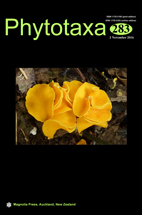Abstract
An ongoing phycological survey of the Laurencia complex in the Mexican Caribbean revealed an undescribed species belonging to Chondrophycus. The new species exhibits vegetative and reproductive structures typical of the genus, except for the presence of a slightly compressed thallus, a translucent outermost cortical cell layer with conspicuous cell wall projections, and tetrasporangia produced from a particular cell with the formation of one additional fertile periaxial cell. The phylogenetic position of this taxon was inferred based on chloroplast-encoded rbcL gene sequence analyses from 54 taxa and using three Rhodomelaceaen taxa as outgroups. The Mexican Caribbean species formed a monophyletic and fully supported clade within the Chondrophycus assemblage, but diverged at 5.8% from the most closely related taxon in the clade, whereas it diverged at 7.5% from the morphologically more closely related species C. dotyi from Kaneohe Bay, Oahu, Hawaiian Islands, indicating that the Mexican Caribbean species is morphologically and genetically distinct from other Chondrophycus species, and supporting its treatment as a new species.

